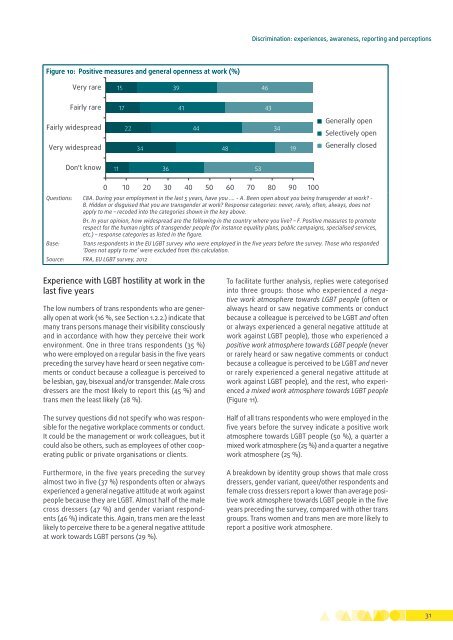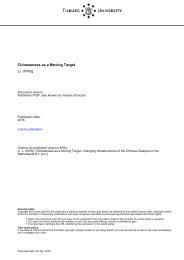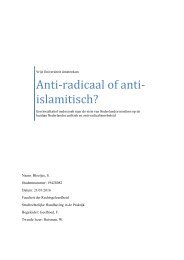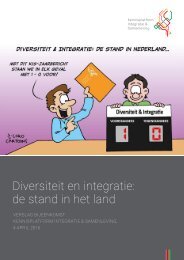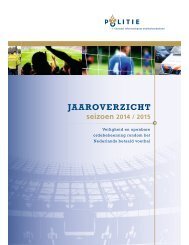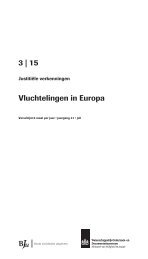fra-2014-being-trans-eu-comparative_en
fra-2014-being-trans-eu-comparative_en
fra-2014-being-trans-eu-comparative_en
You also want an ePaper? Increase the reach of your titles
YUMPU automatically turns print PDFs into web optimized ePapers that Google loves.
Discrimination: experi<strong>en</strong>ces, awar<strong>en</strong>ess, reporting and perceptionsFigure 10: Positive measures and g<strong>en</strong>eral op<strong>en</strong>ness at work (%)Very rare153946Fairly rare174143Fairly widespread224434G<strong>en</strong>erally op<strong>en</strong>Selectively op<strong>en</strong>Very widespread344819G<strong>en</strong>erally closedDon't know1136530 10 20 30 40 50 60 70 80 90 100Questions: C8A. During your employm<strong>en</strong>t in the last 5 years, have you …. - A. Be<strong>en</strong> op<strong>en</strong> about you <strong>being</strong> <strong>trans</strong>g<strong>en</strong>der at work? -B. Hidd<strong>en</strong> or disguised that you are <strong>trans</strong>g<strong>en</strong>der at work? Response categories: never, rarely, oft<strong>en</strong>, always, does notapply to me – recoded into the categories shown in the key above.Base:B1. In your opinion, how widespread are the following in the country where you live? – F. Positive measures to promoterespect for the human rights of <strong>trans</strong>g<strong>en</strong>der people (for instance equality plans, public campaigns, specialised services,etc.) – response categories as listed in the figure.Trans respond<strong>en</strong>ts in the EU LGBT survey who were employed in the five years before the survey. Those who responded‘Does not apply to me’ were excluded from this calculation.Source: FRA, EU LGBT survey, 2012Experi<strong>en</strong>ce with LGBT hostility at work in thelast five yearsThe low numbers of <strong>trans</strong> respond<strong>en</strong>ts who are g<strong>en</strong>erallyop<strong>en</strong> at work (16 %, see Section 1.2.2.) indicate thatmany <strong>trans</strong> persons manage their visibility consciouslyand in accordance with how they perceive their work<strong>en</strong>vironm<strong>en</strong>t. One in three <strong>trans</strong> respond<strong>en</strong>ts (35 %)who were employed on a regular basis in the five yearspreceding the survey have heard or se<strong>en</strong> negative comm<strong>en</strong>tsor conduct because a colleague is perceived tobe lesbian, gay, bisexual and/or <strong>trans</strong>g<strong>en</strong>der. Male crossdressers are the most likely to report this (45 %) and<strong>trans</strong> m<strong>en</strong> the least likely (28 %).The survey questions did not specify who was responsiblefor the negative workplace comm<strong>en</strong>ts or conduct.It could be the managem<strong>en</strong>t or work colleagues, but itcould also be others, such as employees of other cooperatingpublic or private organisations or cli<strong>en</strong>ts.Furthermore, in the five years preceding the surveyalmost two in five (37 %) respond<strong>en</strong>ts oft<strong>en</strong> or alwaysexperi<strong>en</strong>ced a g<strong>en</strong>eral negative attitude at work againstpeople because they are LGBT. Almost half of the malecross dressers (47 %) and g<strong>en</strong>der variant respond<strong>en</strong>ts(46 %) indicate this. Again, <strong>trans</strong> m<strong>en</strong> are the leastlikely to perceive there to be a g<strong>en</strong>eral negative attitudeat work towards LGBT persons (29 %).To facilitate further analysis, replies were categorisedinto three groups: those who experi<strong>en</strong>ced a negativework atmosphere towards LGBT people (oft<strong>en</strong> oralways heard or saw negative comm<strong>en</strong>ts or conductbecause a colleague is perceived to be LGBT and oft<strong>en</strong>or always experi<strong>en</strong>ced a g<strong>en</strong>eral negative attitude atwork against LGBT people), those who experi<strong>en</strong>ced apositive work atmosphere towards LGBT people (neveror rarely heard or saw negative comm<strong>en</strong>ts or conductbecause a colleague is perceived to be LGBT and neveror rarely experi<strong>en</strong>ced a g<strong>en</strong>eral negative attitude atwork against LGBT people), and the rest, who experi<strong>en</strong>ceda mixed work atmosphere towards LGBT people(Figure 11).Half of all <strong>trans</strong> respond<strong>en</strong>ts who were employed in thefive years before the survey indicate a positive workatmosphere towards LGBT people (50 %), a quarter amixed work atmosphere (25 %) and a quarter a negativework atmosphere (25 %).A breakdown by id<strong>en</strong>tity group shows that male crossdressers, g<strong>en</strong>der variant, queer/other respond<strong>en</strong>ts andfemale cross dressers report a lower than average positivework atmosphere towards LGBT people in the fiveyears preceding the survey, compared with other <strong>trans</strong>groups. Trans wom<strong>en</strong> and <strong>trans</strong> m<strong>en</strong> are more likely toreport a positive work atmosphere.31


